In this set of three analyses, I have given a brief tactical analysis of all 18 teams in the Bundesliga.
I teamed up with Zoltan Toth, an excellent data analyst who also writes for the site, and he created these fantastic graphs to highlight every team’s performances based on the same set of metrics.
The yellow in these graphs show possession and this is based on a team’s overall possession percentage along with the number of passes they play per 90. The dark blue part of the graph represents a team’s direct play, combining the number of long passes and progressive passes a team plays per 90. The green, individual progression, also shows the amount of 1v1’s and progressive runs a team makes per 90. The light blue, showing a team’s final third threat, shows the number of touches a player on that team takes before shooting on average, as well as their expected goal minus their expected goal chain. And finally the red, which shows pressing efficiency, combines their PPDA along with their defensive duel success percentage.
In this final part of the series, I will give an analysis of the tactics used by Paderborn, RB Leipzig, Schalke, Union Berlin, Werder Bremen, and Wolfsburg.
Paderborn
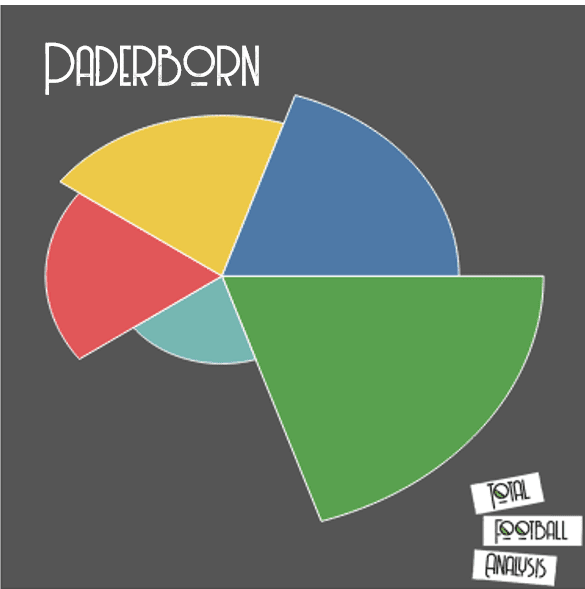
Steffen Baumgart was told before the season that regardless of how this season went, he wouldn’t lose his job. That’s a mature approach from the board, as Baumgart is an excellent coach, working on a shoestring budget. Paderborn have grown a reputation of finding hidden gems for little to no transfer fee, and last summer Sorting Director Markus Krösche was pinched by RB Leipzig for the same role, replacing the legendary Ralf Rangnick. But Krösche oversaw a programme which looked to bring in undervalued talents and get the most of them, helping Paderborn work their way back up the leagues, and several of these players will no doubt move this summer for far more than Paderborn paid.
This season they have considerably underperformed their expected points total, which suggests that luck has not been on their side, but truthfully it would take a miracle for them to stay up this season as they languish at the bottom of the table on 16 points.
We can see from looking at their graph above that they favour playing directly, and look for their players to progress the ball individually.
Paderborn averages 34.05 dribbles per game, with only Bayern Munich with a slightly higher amount (34.47), but obviously they have a far greater amount of possession. Paderborn’s completion percentage on these though is just 49.9%. These dribbles come from their wingers or full-backs, generally Gerrit Holtmann and Kai Pröger, who both rank inside the top six players in the league for dribbles attempted.
Pröger, in particular, has a good understanding of space around him and Baumgart clearly encourages him to take on players even if there is perhaps space for a cross or pass, like in the image below.
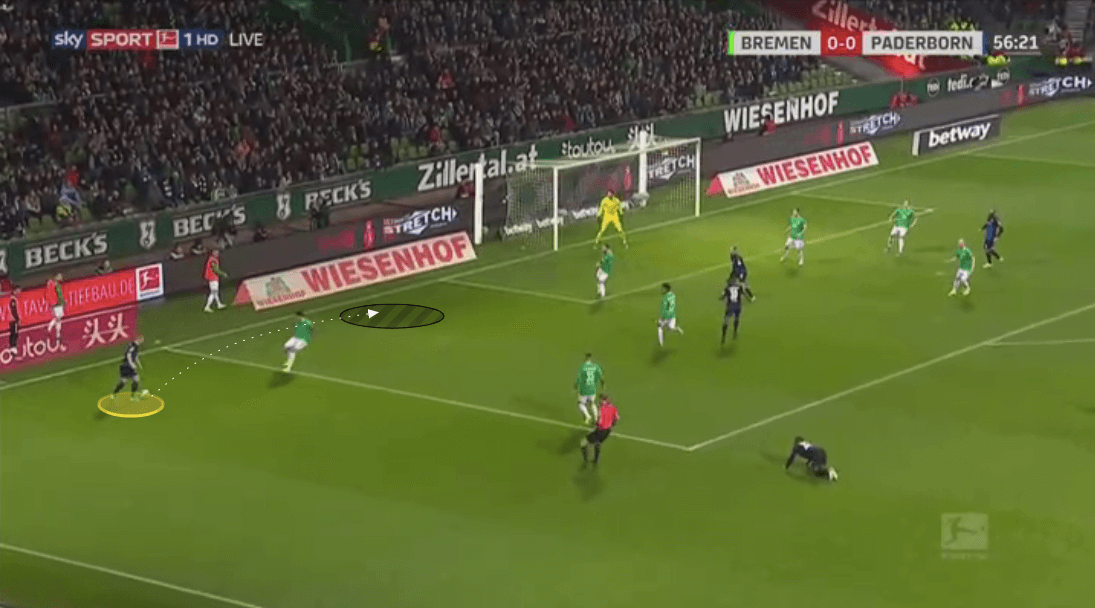
They started the season with quite an aggressive counter-attack, and were successful with this approach, but have become more cautious as the season has progressed. They were promoted last season from the 2. Bundesliga despite a leaky defence and that trend has continued, as they have conceded 54 goals this campaign, greatly underperforming against their xGA of 43.02.
They generally line up in a 4-4-2 formation, and will often initially look to play out from the keeper to the two centre-backs as they split wide, and seek to encourage the opposition press forward. They will then quickly look to play forward with direct passes either to the wing or the forward line. Both Streli Mamba and Sven Michel, for example, are quick forwards and simple balls over the top have been effective. Otherwise, they will look for basic movement from the front two with one dropping in to create space behind for the other to run into. They are able to draw defenders out by using their wingers to stretch the back four, as we can see in the image below.
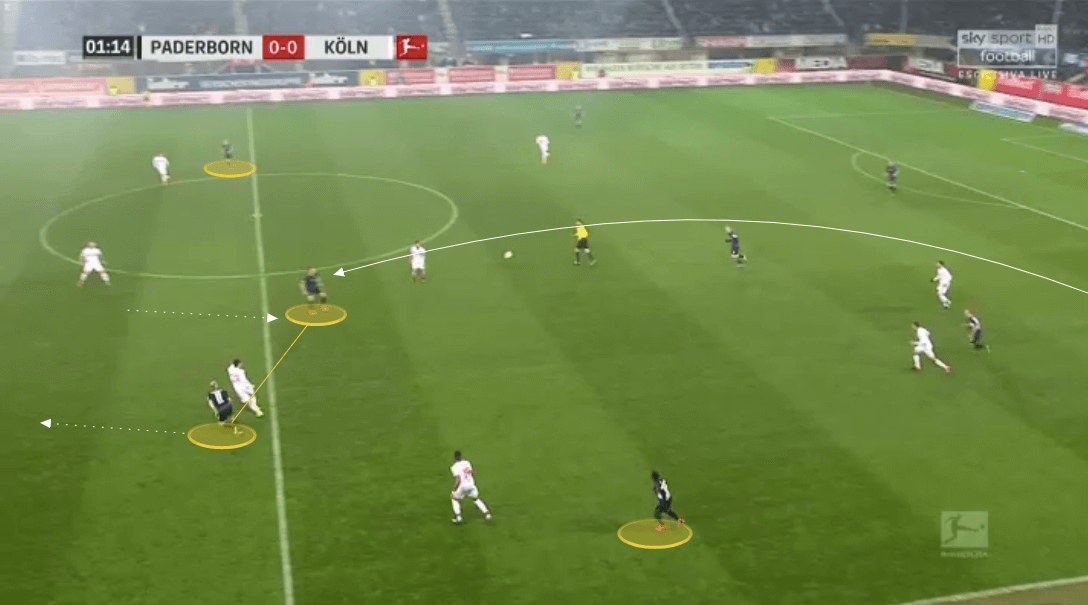
Paderborn fans will still believe they are capable of an unlikely escape. Despite difficult fixtures against Borussia Dortmund, Leipzig and Mönchengladbach to come, they do still have to play three of the four teams above them in the form of Düsseldorf, Augsburg, and Werder Bremen. Wins against those sides, and picking up an unlikely result or two elsewhere and they could be in with a chance of at least making it to the relegation playoff game.
Key players: Sebastian Vasiliadis, Pröger, Jamilu Collins
Expected points: 24.6
Actual points: 16
Remaining fixtures: Fortuna Dusseldorf (a), Hoffenheim (h), Augsburg (a), Borussia Dortmund (h), Leipzig (a), Werder Bremen (h), Union Berlin (a), Borussia Monchengladbach (h), Eintracht Frankfurt (a)
RB Leipzig
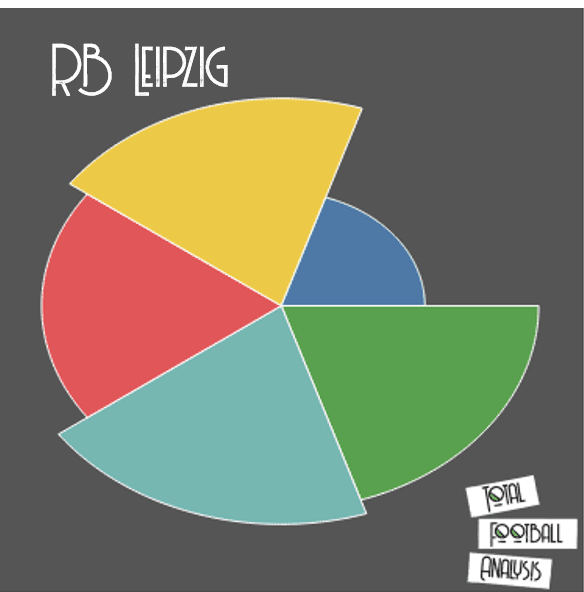
Leipzig are five points adrift of league leaders Bayern Munich, with 50 points and are in third place. However, their remaining fixtures are incredibly kind (other than Dortmund at home on the penultimate game of the season), and they will definitely fancy their chances of getting back into serious contention for the title.
The dark blue section of the graph above tells us that they aren’t a direct team, at least not in the sense of how we have characterised direct play. Leipzig doesn’t engage in a great deal of long passes, however, they are direct in the sense of their desire to get the ball forward as their number one in possession priority. Head Coach Julien Nagelsmann values vertical passing and although they won’t necessarily dominate in possession, they are very effective with it, looking to break the lines with forward passes. They generally look to make no more than three or four passes before playing forward and will use a compact midfield to counter-press effectively to ensure the ball stays in high areas.
Leipzig are flexible with their formations and have recently shown a penchant for a 3-5-2. The role of their wing-backs differs when they play this formation. If Tyler Adams is used at right wing-back, he will often seek to invert and give Leipzig another option in central-midfield during build-up and Lukas Klostermann push wide into the right-back position.
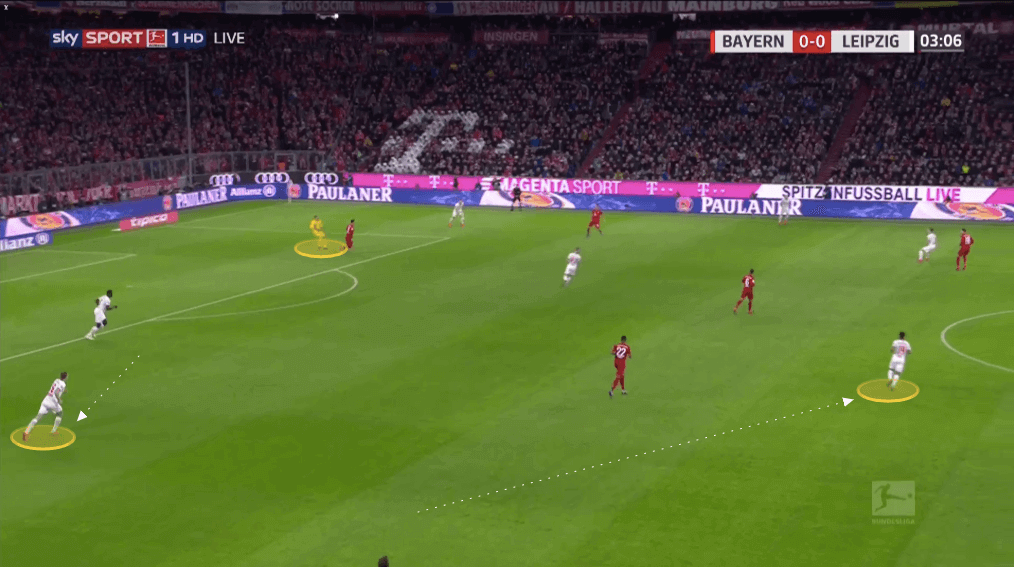
Nordi Mukiele, on the other hand, is a more attack-minded wing-back, and will often push up in attack to join the front two of Timo Werner and Patrik Schick. Mukiele is very quick and it’s not rare to see him as the furthest forward player in attack as he makes late diagonal runs behind his front two, looking for balls in behind.
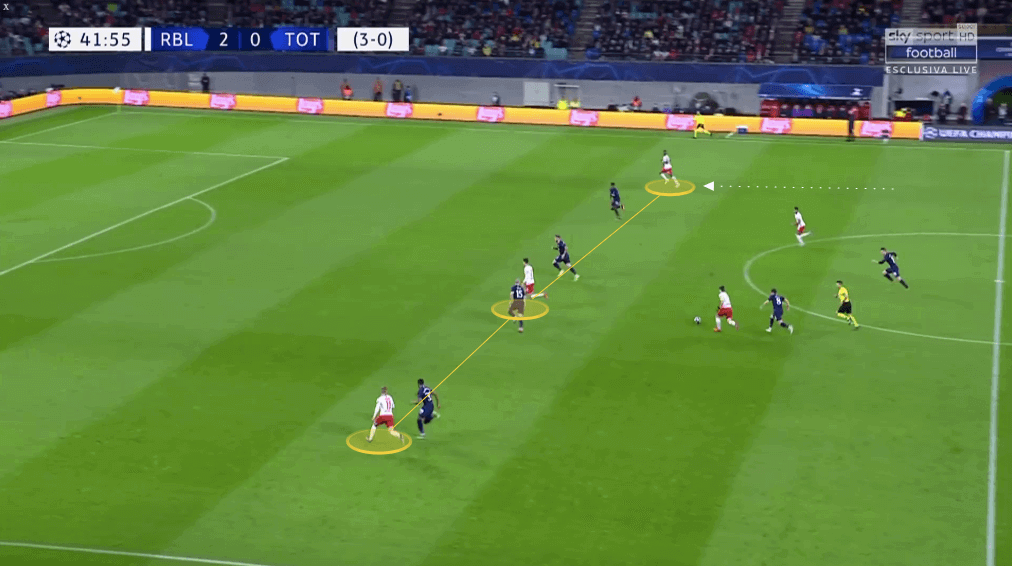
In doing this, it allows Werner to shift over to the left flank, which he is very fond of doing. Werner looks to peel off the right centre-back or even right-back, and receive in the space created by his slightly looped run. He will also take wide positions on the left side and receive the ball to feet, before cutting inside to shoot. Schick stays central during this and works as a target man.
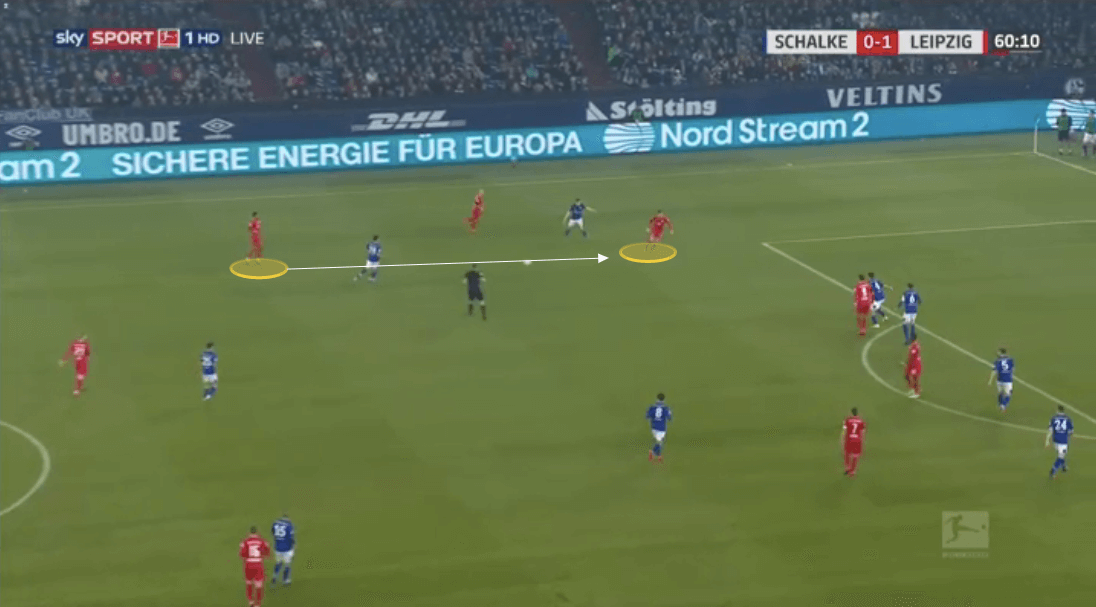
Premier League fans will recognise Manchester City’s Angeliño playing for them at left wing-back. He fits into this system perfectly as at wing-back he doesn’t get isolated in the defensive phase and exposed in this way, but he is good on the ball, will get forward, but still allow space for Werner to push over and work on the left flank.
In midfield, Christopher Nkunku has shone this season and played well in a plethora of positions. Nkunku is one of the most creative players in the league and has 14 assists to go with his four goals. If he can improve his goalscoring tally he could take his game to another level.
Marcel Sabitzer is the driving force in midfield. A brilliant box to box midfielder with a good passing range and dribbling ability, Sabitzer is the ball-progressor in the centre, playing alongside Konrad Laimer, who is the ball-winner. Sabitzer has been operating in central midfield recently as part of a staggered double pivot with Laimer. Nagelsmann greatly favours using a double pivot to aid ball progression but also to prevent teams countering in a central position.
At the back, newcomers to the league will no doubt be curious to watch Dayot Upamecano. His ceiling is through the roof and is already an excellent centre-back who is physical with great ball-playing attributes too. Upamecano is usually the preferred option of Leipzig to play out from the back, however, both Marcel Halstenberg and Klostermann are good on the ball too.
Key players: Werner, Sabitzer, Nkunku
Expected points: 48.2
Actual points: 50
Remaining fixtures: Freiburg (h), Mainz (a), Hertha Berlin (h), Koln (a), Paderborn (h), Hoffenheim (a), Fortuna Dusseldorf (h), Borussia Dortmund (h), Augsburg (a)
Schalke
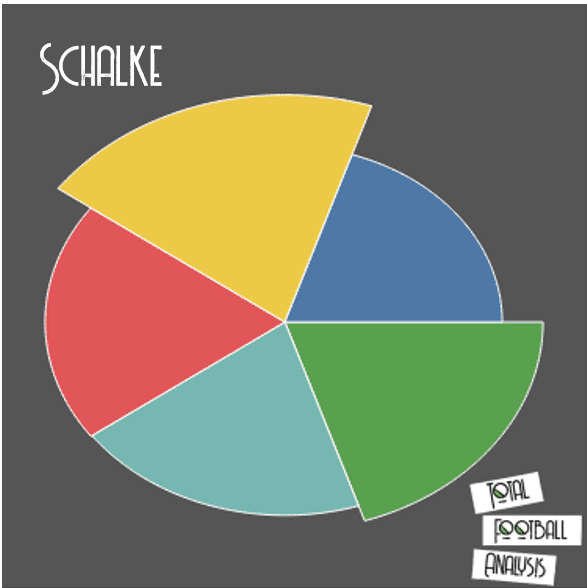
Under David Wagner, Schalke have had yet another new dawn, and are currently in the last Europa League qualification place in the table. However, Wolfsburg and Freiburg are only a point behind them, whereas Hoffenheim are two points behind them. There is plenty left to play for in the battle for sixth place.
They will play a 4-4-2 using a diamond and will use this both in and out of possession.
In build-up Omar Mascarell plays very close to the centre-backs, and will often drop in between them as the full-backs will push up, so you’ll often see Schalke building up with a back three.
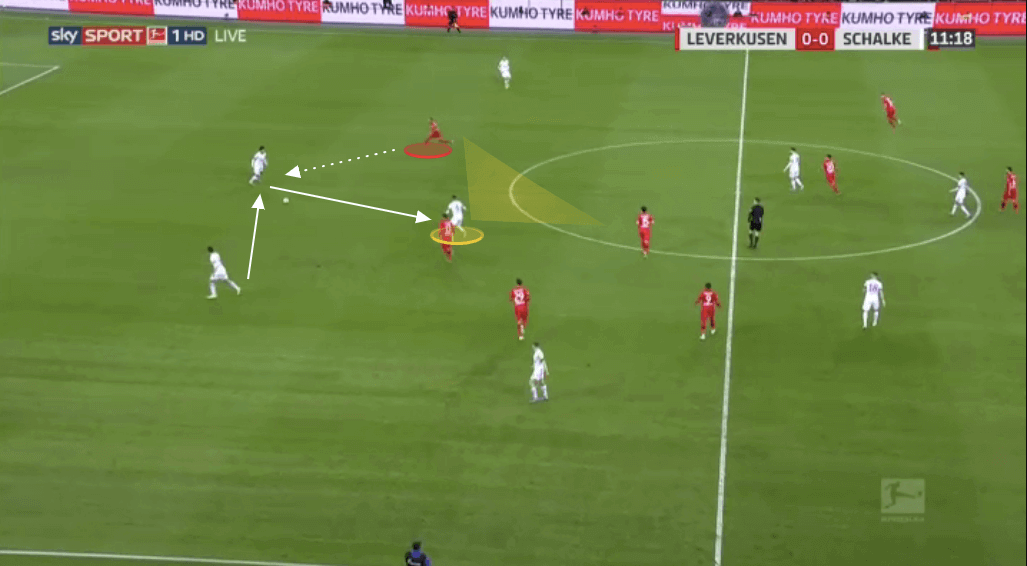
As much as this to get Mascarell on the ball it’s to make sure they are less vulnerable to counter-attacks as should they enter into defensive transition they have a tight back three.
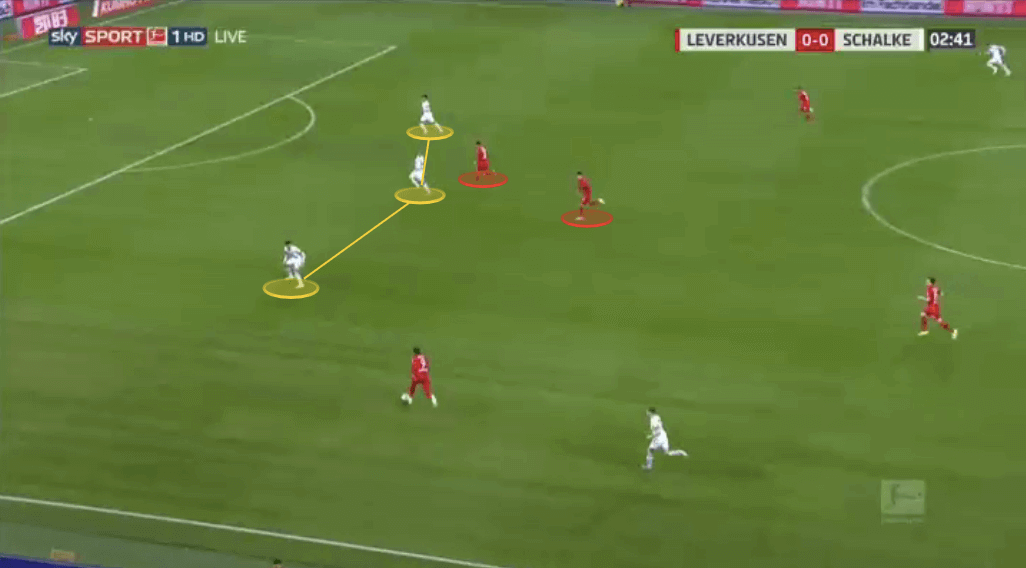
Schalke are direct on the ball, and look to get the ball early into one of the forwards, or will play the ball laterally and have their full-backs look to hit the ball down the line, over the opposition full-back.
Their attack is similar in some ways to Leipzig’s at least in terms of principles, of getting the ball forward quickly and then using their pressing structure to win the ball back in a high area against an unbalanced defence. Therefore the majority of their chances come from transitions and winning the ball back.
The big difference between them, and a team like Leipzig for example, is that the latter have a whole range of elite attacking talent, whereas Schalke doesn’t. Schalke are therefore more reliant on this approach, and arguably more gutsy in their commitment to the press. They have a 9.96 PPDA, and average 6.7 duels, tackles and interceptions per minute of opposition possession. Only Leverkusen and Bayern have higher.
They press in their 4-4-2, with a compact diamond which forces the opposition to play wide as it is so congested inside. As soon as it’s worked wide Schalke look to trap teams, force mistakes, and potentially win the ball back in high areas. They have done very well against good teams like the aforementioned Leipzig, and Gladbach too, where they were able to trap them in these wide areas. If they win the ball back their diamond structures their counters too, with the pivot playing into the top of the diamond. This pass is followed by forward runs from the two widest players in the diamond in the half-spaces to progress the ball quickly.
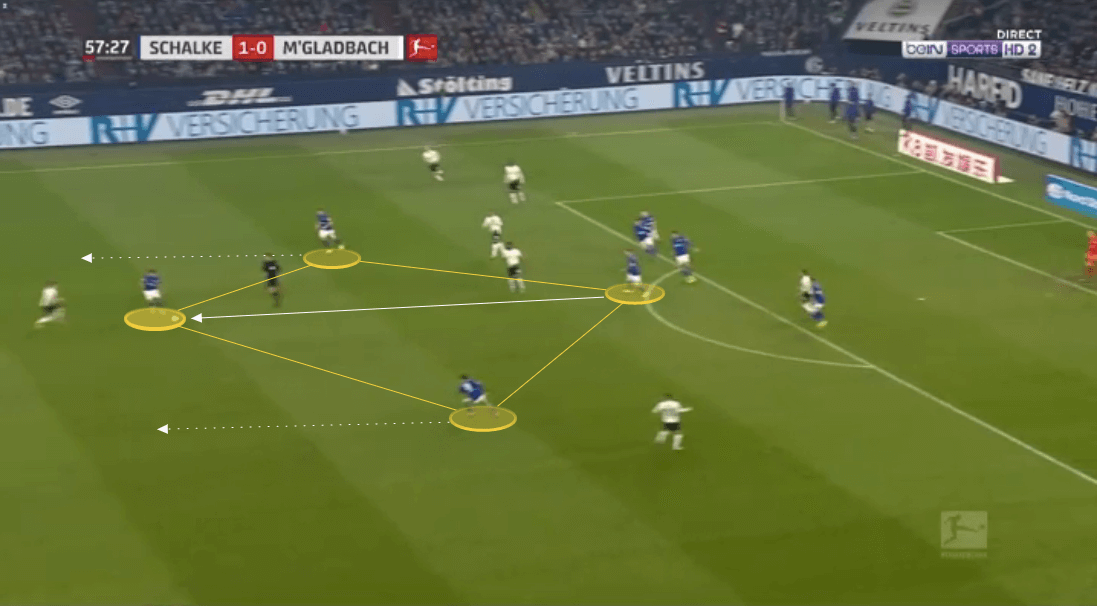
Some teams may seek to break their press by going long, but they have centre-backs who are very strong aerially.
On the flip side, we have seen Schalke struggle this season against weaker teams who have surrendered possession. Firstly this isn’t how Schalke want to play, and secondly, they don’t have the creative talents to break these kinds of teams down. Their 31.14 xG this season is less than both Mainz and Werder Bremen.
Their press is so important to the style, and against good ball-playing teams they may struggle because it’s so vital to everything they do. Dortmund and Leverkusen, who they still have to play, will believe they can break down these presses, as long as they don’t get stuck in the wide areas.
Key players: Amine Harit, Suat Serdar, Benito Raman
Expected points: 30.5
Actual points: 37
Remaining fixtures: Borussia Dortmund (a), Augsburg (h), Fortuna Dusseldorf (a), Werder Bremen (h), Union Berlin (a), Bayer Leverkusen (h), Eintracht Frankfurt (a), Wolfsburg (h), Freiburg (a)
Union Berlin
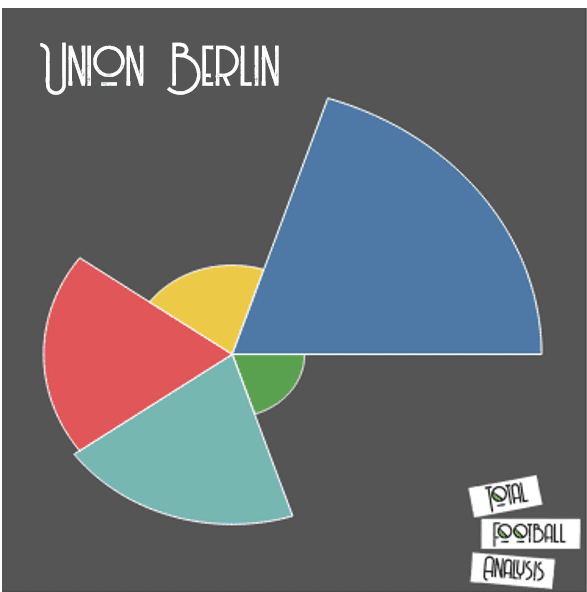
If you catch a Union Berlin game for the first time you would be forgiven for thinking you’d tuned in to watch the Crazy Gang. Ok perhaps that’s a little harsh, but Union is playing a very effective form of long ball football. From the graph, you could surmise they don’t have a lot of possession and they don’t have individuals who will progress the ball with runs or dribbles and you’d be right. Their lack of possession comes from their passing style, and their desire to get the ball forward as quickly as possible.
They average 52.2 long balls per 90, which is the most in the league, with an incredible 60.9% completion. Both Marvin Friedrich and Neven Subotić have just shy of 60% completion on their long passes and goalkeeper Rafał Gikiewicz has superb distribution. As much as they play traditional balls up to the target man, they will play high percentage long passes in between the lines and in the wider areas where the recipient will have an immediate option behind, laterally, and in front to secure the ball.
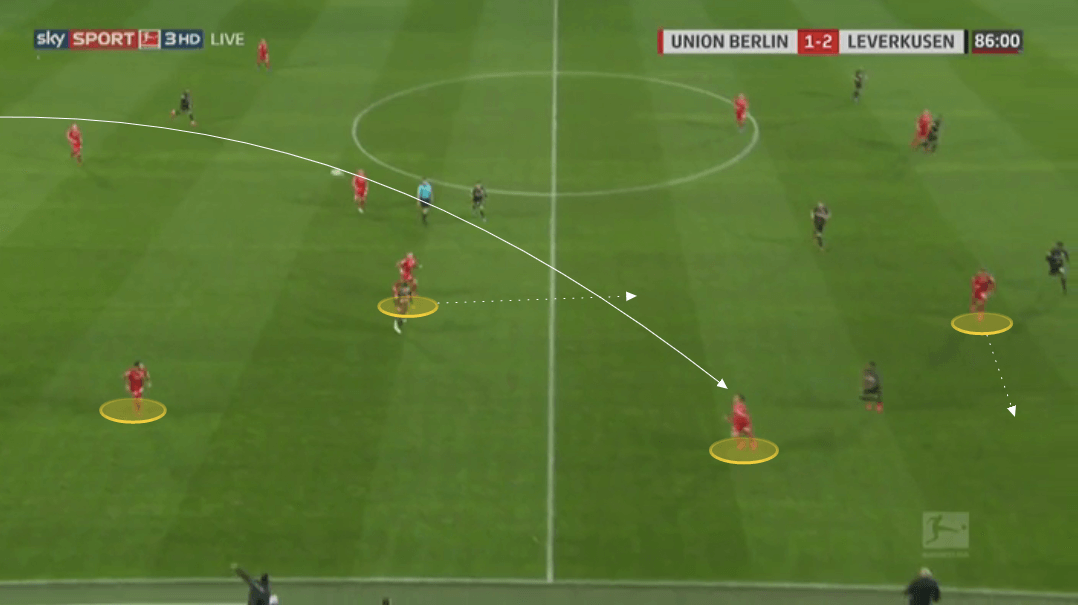
Similarly, with their balls directly into the forward line, they will support these areas well.
They have old fashioned wingers who other than dropping into the half-spaces to support the target man, Sebastian Andersson, will run relentlessly up and down their flanks looking to put crosses into the box, but as alluded to, aren’t the types of players to drop deep and look to take their opposition number on.
One of their best attacking weapons has been from their set-pieces where they have scored goals. I was discussing Union with fellow analyst Cam Meighan last week and he pointed out that Union averages a 0.23 xG per five corners, which is staggeringly good.
Union isn’t short of tall players and the likes of Andersson, Friedrich, Subotic will all crash towards the six-yard line from corners to meet Christopher Trimmel’s low pinpoint crosses. Trimmel has eight assists in all competitions this season.
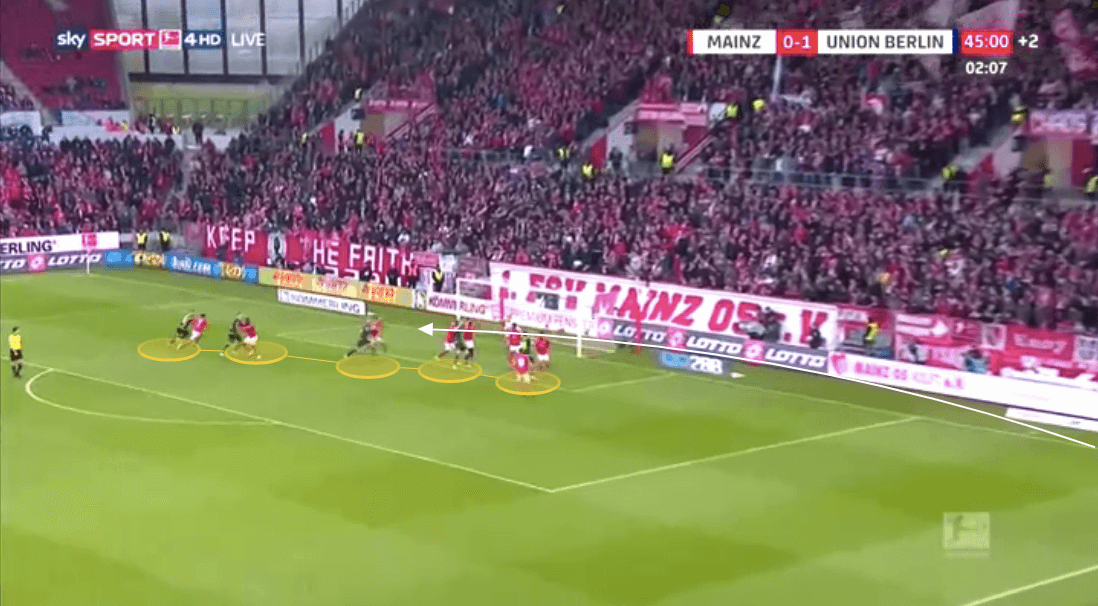
Long ball teams often have a connotation of being defensive, and although they are relatively cautious out of possession, leaving little space between their lines for teams to play through, they will commit plenty of players forward in an attacking sequence.
Union sit in 11th place on 30 points which is a pretty comfortable mid-table position, however, they’re not quite in mid-table obscurity yet. They could make a late push for the European places, or they may get pulled into the relegation dogfight. Two of their first three games back are against Hertha Berlin and Mainz, and the results will give us a good idea whether their fans should be looking down or up for the remainder of the season.
Key players: Andersson, Trimmel, Gikiewicz
Expected points: 31.7
Actual points: 30
Remaining fixtures: Bayern Munich (h), Hertha Berlin (a), Mainz (h), Borussia Monchengladbach (a), Schalke (h), Koln (a), Paderborn (h), Hoffenheim (a), Fortuna Dusseldorf (h)
Werder Bremen
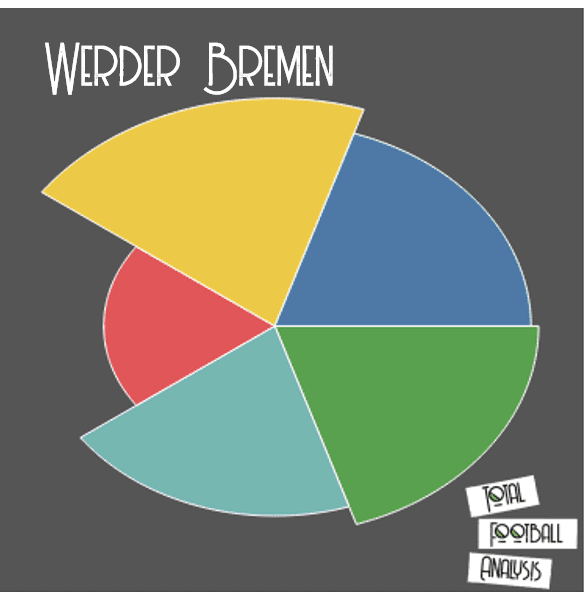
Werder Bremen are a huge club and are in serious danger of dropping into the 2. Bundesliga. In fact, it is very likely. They have stuck with young Head Coach Florian Kohfeldt – a move against the grain of how most modern football clubs run. The board believe he is the right man for the club, and playing the brand of passing football they want to be associated with Bremen. But they are in dire straits, sitting in 17th position on just 18 points. Their run of fixtures to the end of the season isn’t exactly kind either and they will do well to even muster a fight to stay up.
Along with Dusseldorf they have scored the least amount of goals in the league, and are an example of what happens if you don’t replace your outgoing players. Max Kruse left last summer after scoring 20 goals. This season Werder Bremen have scored just 27.
Bremen have a lot of possession for a team so low in the table and will look to play out, and predominantly aim to keep the ball on the floor. They will always build-up with their centre-backs splitting wide and getting into possession, before looking to play through the thirds. Their wing-backs stay deep and wide to stretch the press and open up the half-spaces for ball progression, whilst there are options inside from the half-space to secure the ball.
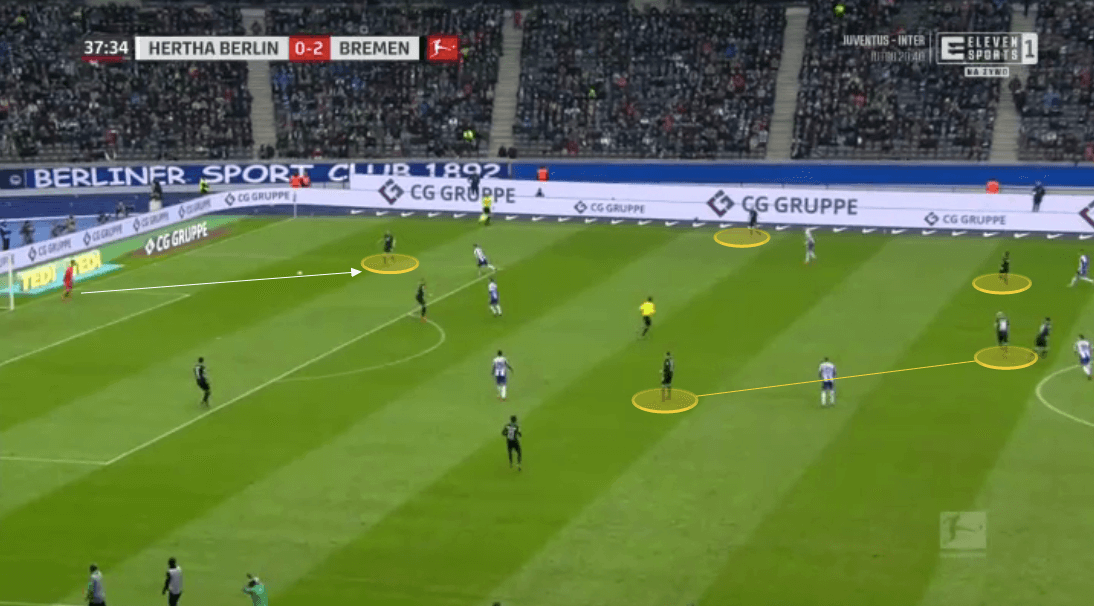
They are pretty resolute in playing like this, however, they have players who can hurt the opposition with more direct play too. The likes of Rashica will operate in the half-spaces and if they do go long, Rashica will move behind a decoy run from the centre-forward to potentially get onto a ball over the top, however, the majority of their longer passes will be seen in switches of play, rather than balls up to a target man.
As admirable as their approach is, they’re playing this way against frankly better teams who are very good at counter-attacking, as many teams are in the Bundesliga. These sides will either sit back and counter, or press and counter, but the result has been the same, and Bremen have been carved open too easily on too many an occasion this season.
Defensively they have not been good enough at defending transitions. It’s been a mixture of poor performances, poor organization, and poor mistakes which have left them where they are having conceded 55 goals. Goals like the one below where a defensive transition leads to a forward ghosting through the defence unmarked to tap in a cross are an all too familiar occurrence and lets not even talk about set-pieces. Incredibly 14 of their 54 conceded goals have come from set-pieces. This has been an issue all season, and they still don’t look any better defending them.
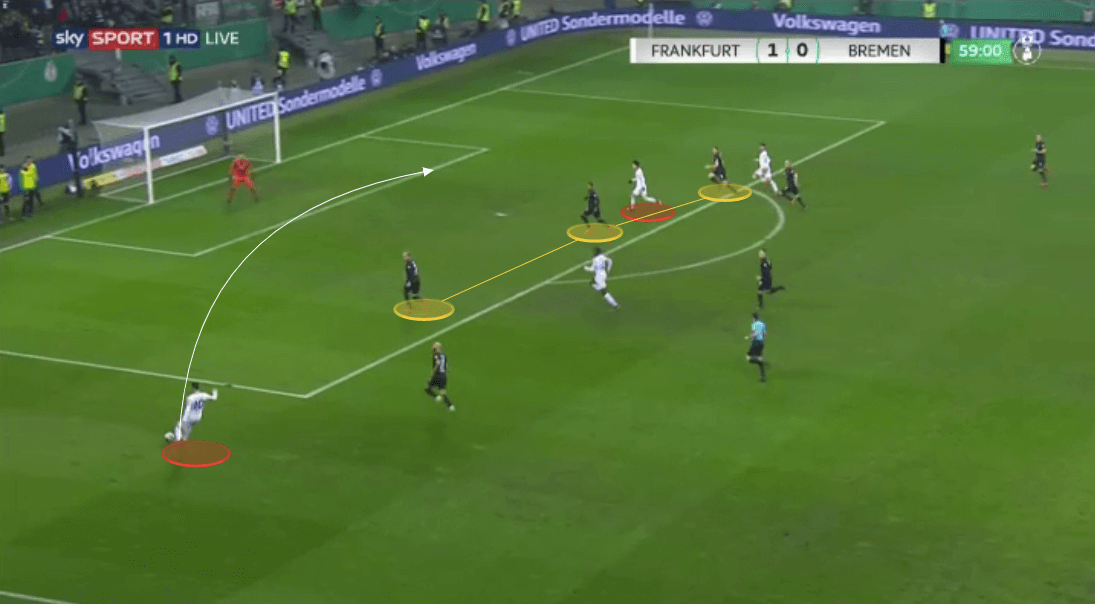
Key players: Milot Rashica, Maximilian Eggestein, Davy Klaasen
Expected points: 29.8
Actual points: 18
Remaining fixtures: Bayer Leverkusen (h), Freiburg (a), Borussia Monchengladbach (h), Schalke (a), Eintracht Frankfurt (h), Wolfsburg (h), Paderborn (a), Bayern Munich (h), Mainz (a), Koln (h)
Wolfsburg
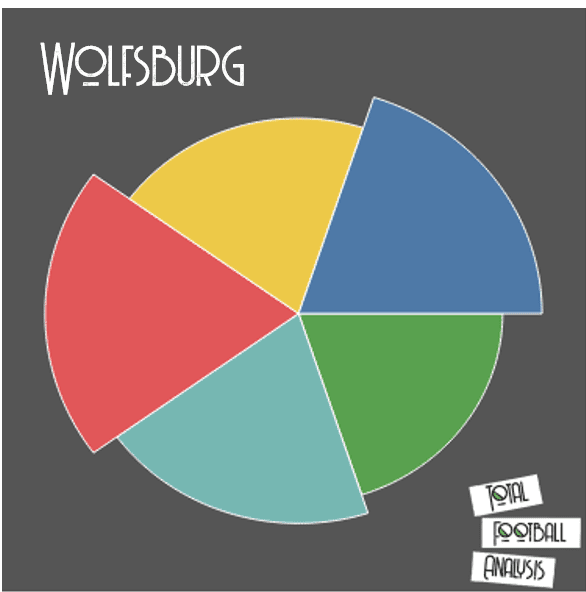
Wolfsburg had a phenomenal start to the season, which cooled very quickly, however, they currently reside in 7th place, well in the fight for the Europa League places.
Wolfsburg started the season under Oliver Glasner using his favoured 3-4-3 formation, however, a succession of bad results led Glasner to hit the panic button and abandon the back three, changing to a back four. I believe he will return at some point to the back three (maybe even in this run-in to the end of the season), but his core of not exactly mobile central-defenders (Jeffrey Bruma, who was moved to Hertha Berlin in January, John Brooks, Marcel Tisserand and Robin Knoche), meant as physically and aerially dominant as these players were together, against quick and vertical passing teams (Dortmund, Leipzig), their back three was exposed, and surely would have continued to have been had Glasner persisted. He brought in Marin Pongračić in January who looks to have plenty of potential, and will help them return to using a back three, but he hasn’t solidified a starting place, with him generally opting for Knoche and Brooks with Kevin Mbabu and Jérôme Rousillon, or Renato Steffen and Paulo Otávio, either side.
The defence has improved and Wolfsburg is a solid side, difficult to break down and with a robust pressing system too where they press high, prevent teams from getting comfortable in possession, and will counter-press when they have lost the ball too.
In attack, they have the ever reliant Wout Weghorst, who is a talented target man and a good finisher. They will use him as an outlet, and as we can see from the graph will play long balls, but are still relatively committed to playing out, and have talented ball-players in their team. In central-midfield Xaver Shlager has had a strong debut season in the league and is a very good ball-progressor, although is often used as a number 10, or even as a second striker.
Around Weghorst, they have quick and skilful attacking players. Josip Brekalo has had a much better second half of the season as well as the previously mentioned Steffen, and Admir Mehmedi. These players often push into the half-spaces, particularly when they play with a back three, as the wing-backs can occupy the flanks, and are an outlet Wolfsburg will consistently use to get behind defences.
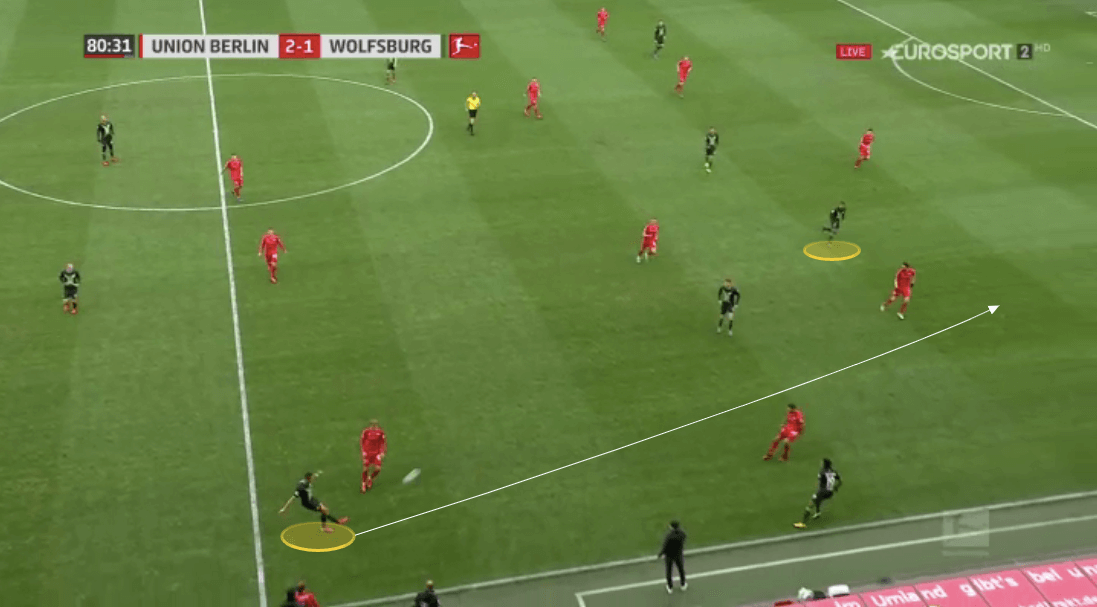
These players are also given the license to take on opponents and are good at getting in behind before pulling the ball back for their teammates in and around the six-yard box. Wolfsburg commits players to their counter-attacks where these kinds of opportunities can be so potent, as the defence trackback, watch the ball-carrier and have to be aware of the runs being made behind them into the box.
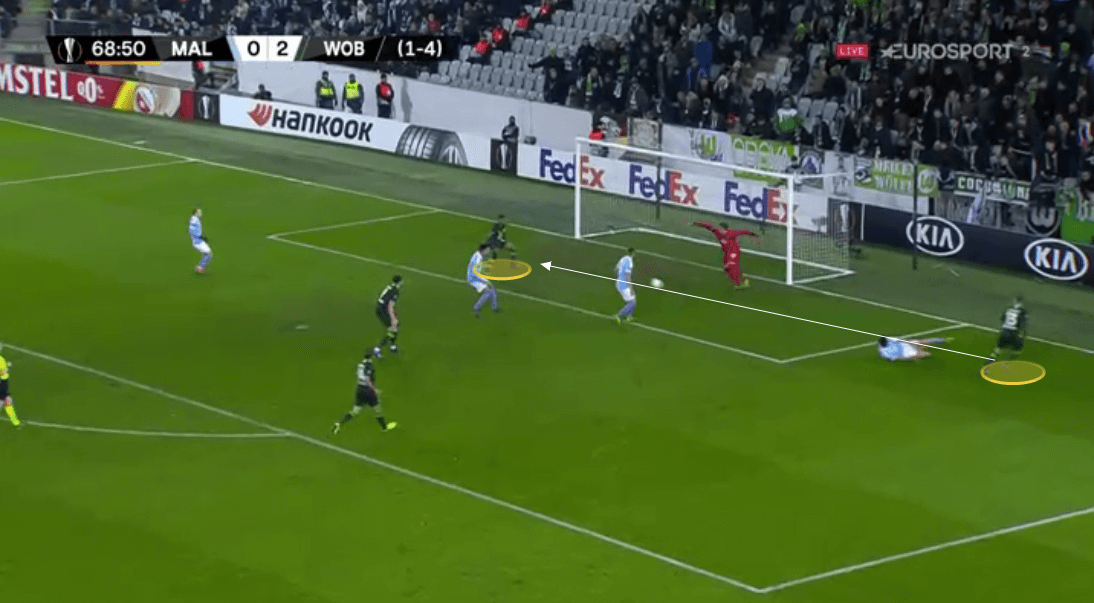
From looking at Wolfsburg’s graph they are probably the most rounded team we have analysed in this series, in terms of incorporating a range of different aspects into their game.
Key players: Wout Weghorst, Josip Brekalo, Xaver Shlager
Expected points: 39.3
Actual points: 36
Remaining fixtures: Augsburg (a), Borussia Dortmund (h), Bayer Leverkusen (a), Eintracht Frankfurt (h), Werder Bremen (a), Freiburg (h), Borussia Mönchengladbach (a), Schalke (a), Bayern Munich (h)
Conclusion
It is difficult to go into too much detail on these teams, and there is plenty missing in these brief analyses, however, hopefully there is enough here for you to go into the weekend’s fixtures with an idea on the how these six teams play, and you may well recognize some of the tactics highlighted in this analysis.
You are going to love what Total Football Analysis are bringing you this weekend.
Starting with the Reiverderby in the German Bundesliga this coming Saturday, May 16 – Total Football Analysis will be bringing you live match commentary and analysis of Borussia Dortmund vs Schalke, kicking off at 14:30 UK.

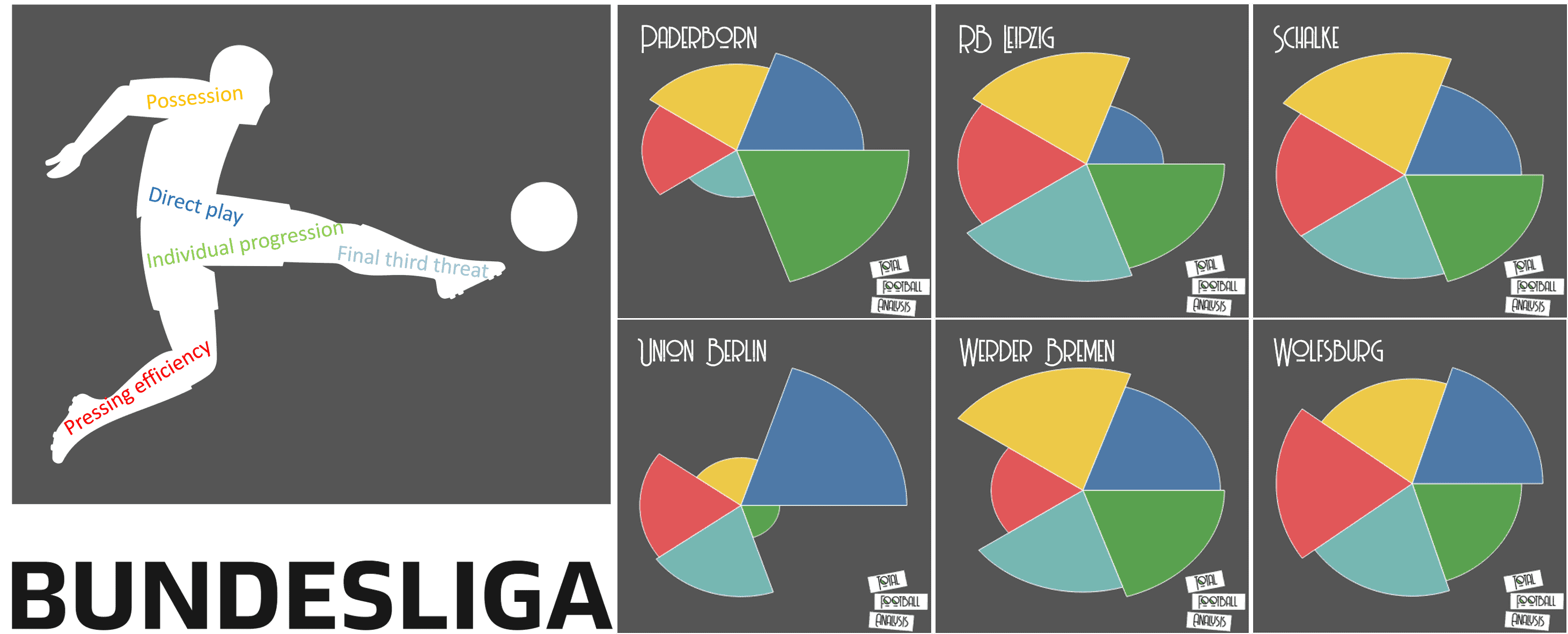



Comments